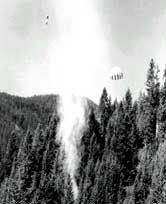Battling blaze up there
 for aerial fire-fighters, exchanging information over vast expanses of flaming wilderness is fraught with high risk and exigency . In an effort to improve the safety and efficiency of aerial fire-fighting, four us-based agencies, the National Aeronautics and Space Administration (nasa), the Bureau of Land Management, the United States Department of Agriculture (usda) Forest Service and the Nevada Division of Forestry are working on a project to examine and evaluate aerial fire-fighting communications and airspace structures over wildland fires.
for aerial fire-fighters, exchanging information over vast expanses of flaming wilderness is fraught with high risk and exigency . In an effort to improve the safety and efficiency of aerial fire-fighting, four us-based agencies, the National Aeronautics and Space Administration (nasa), the Bureau of Land Management, the United States Department of Agriculture (usda) Forest Service and the Nevada Division of Forestry are working on a project to examine and evaluate aerial fire-fighting communications and airspace structures over wildland fires.
The agencies are also evaluating an electronic advanced navigation display system (ands) developed by nasa's Ames Research Center, Mountain View, California, to aid aerial fire-fighters in their communications and operations.
"This project will potentially help aerial commanders direct their assault on a wildland fire by simplifying, standardising and reducing their verbal communication," said Ames' Vernol Battiste, the project's principal investigator and a former air traffic controller. "Loss of situational awareness by pilots in high workload situations often has disastrous consequences," he said.
During the project's first phase, which was scheduled to begin last month, in-cockpit, air-to-air and air-to-ground communications will be recorded and data regarding workload of pilots will be collected. "This will be accomplished through mini-cameras installed in the cockpits of the aircraft, as well as through a post-flight questionnaire to be completed by the pilot and the crew," said Hugh Carson, project leader and aviation manager of the Bureau of Land Management, Nevada.
Five fire-fighting aircrafts based near Reno, Nevada, will be used during the data-gathering phase of the project. The aircrafts include an ov -10 lead plane, a Commander 500 air attack aircraft, two p2v airtankers and a Bell 204 helicopter. Each aircraft will be installed with audio-video recording capability and a prototype of ands.
The ands shows the position of other fire-fighting aircrafts, establishes an airspace structure graphically on the computer screen, identifies areas needing fire retardants or water drops and transmits those images to other aircrafts. The display system uses Pentium-class computers, graphic displays using cd-rom, moving maps, radio modems, and global positioning system signals to show each aircraft's position and to provide two-way data communication between aircrafts. nasa researchers will also be testing the integration of forward-looking infrared technology with the navigation display.
Carson said the system's success will be dependent largely upon whether it can assist the pilot or air tactical supervisor in his or her tasks. "It must be a human-aiding tool," Carson said. "This aspect of the project will be totally driven by user feedback. It has the potential to significantly reduce the need for verbal communications. However, if the pilots and air tactical supervisors do not like it or use it, it is not going to end up in our airplanes." Battiste said that the human-machine interface of the ands and the challenges it presents in a high workload situation such as aerial fire-fighting, is a critical part of this study.
According to Lanny Allmaras, national aerial attack systems specialist for forest service at the National Interagency Fire Center, Boise, Idaho, the basic objective during the first phase of the project is to gather information about what actually goes on in and outside the cockpit of an aircraft during aerial fire-fighting operations.
"Communications issues are frequently brought up at many post-fire reviews, as well as at aerial fire-fighter meetings," Allmaras said. "Whether or not the hardware technology can assist us in doing a better job remains to be seen, but we welcome an outside look by nasa, a proven world leader in aeronautics, communications and human factors research."
Under an interagency agreement signed last year, the Bureau of Land Management and the usda Forest Service are responsible for providing nasa with sufficient data to accomplish its research. Tests and data collection during actual fire-fighting missions might continue into the 1997 fire season.
nasa will then make recommendations to the fire agencies concerning communications, airspace structure, training and the display system.The fire agencies will examine these recommendations, consider available funding, and decide on implementing the proposal.
Related Content
- Wildfires rage across Britain after hottest winter day on record
- 14,000 firefighters battling 18 major California blazes
- Firefighters continue to battle Royal National Park bushfire
- Los Angeles 'turns corner' on largest wildfire in city history
- Firefighters battle spreading wildfire near Athens, homes damaged
- Spain forest fires force evacuation of residents and tourists
